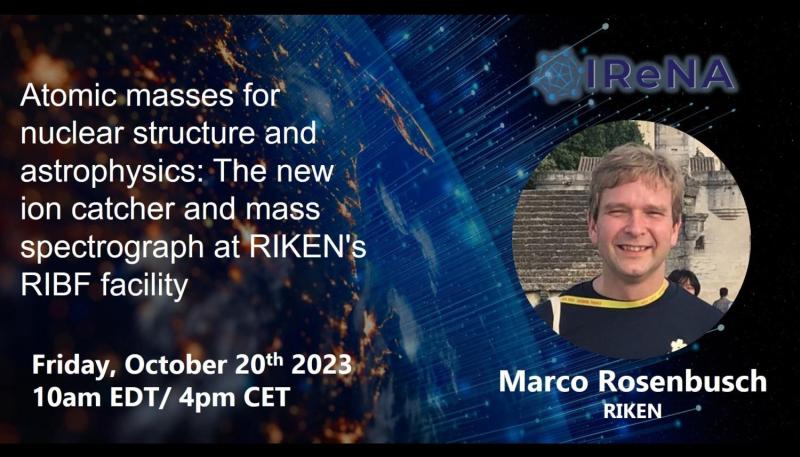Data
Atomic masses for nuclear structure and astrophysics: The new ion catcher and mass spectrograph at RIKEN's RIBF facility featuring Marco Rosenbusch (RIKEN)

*Please note that this seminar will take place at 10am Eastern Time*
Hosted by: Shun Iimura (Rikkyo University)
Exploiting closed-path ion trajectories in an electrostatic ion trap, the multi-reflection time-of-flight mass spectrograph (MRTOF-MS) [1] is one of the most promising techniques for precise mass measurements of very short-lived isotopes. Exotic ions produced at radioisotope facilities are stored in an electrostatic trap at kinetic energies on the order of a few keV, reflected back and forth between two electrostatic ion mirrors, and ultimately ejected to a detector for time-of-flight (TOF) determination. By comparison with precise TOF data obtained from ions of well-known mass, the mass of an unknown ion can be calculated with relative uncertainties reaching 𝛿m/m < 5x10-8 using state-of-the-art technology.
At the RIBF/BigRIPS facility of RIKEN (Wako, Japan) the new ZD-MRTOF system [2,3] located downstream of RIBF's ZeroDegree (ZD) spectrometer has been put into operation. The precision mass spectrometer is coupled to a cryogenic helium-gas filled ion catcher [4], where the initially relativistic reaction products are stopped, thermalized, and extracted as ions to be forwarded to the MRTOF-MS.
Since autumn 2020 exotic ion beams are provided to our new setup, and previously unknown radioactive isotope masses, or those with large mass uncertainty, have been determined with high precision and accuracy. This contribution will focus on the success of this setup and the recent nuclear mass measurement achievements. I will present our performed experiments including masses in the region between neutron-rich Ga and Br isotopes, and new results in the region of Mo around N = 70. Furthermore, our physics results include insights into the development of tensor interactions between Ca and Cr isotopes, and also recent highlights from two other MRTOF facilities at RIBF will be presented.
I will give an outlook for a near-future program for combined experiments with decay spectroscopy, and if time allows, some technical efforts to improve the mass accuracy for future measurements will be shown.
